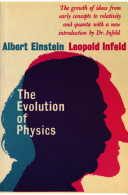Understanding Heat and Temperature
Our sense of touch tells us quite definitely that one body is hot and another cold. But this is a purely quali- tative criterion, not sufficient for a quantitative descrip- tion and sometimes even ambiguous. This is shown by a well-known experiment: we have three vessels con- taining, respectively, cold, warm and hot water. If we dip one hand into the cold water and the other into the hot, we receive a message from the first that it is cold and from the second that it is hot. If we then dip both hands into the same warm water, we receive two con- tradictory messages, one from each hand. For the same reason an Eskimo and a native of some equatorial coun- try meeting in New York on a spring day would hold different opinions as to whether the climate was hot or cold. We settle all such questions by the use of a thermometer, an instrument designed in a primitive form by Galileo. Here again that familiar name ! The use of a thermometer is based on some obvious physical assumptions. We shall recall them by quoting a few lines from lectures given about a hundred and fifty years ago by Black, who contributed a great deal toward clearing up the difficulties connected with the two concepts, heat and temperature:
By the use of this instrument we have learned, that if we take 1000, or more, different kinds of matter, such as metals, stones, salts, woods, feathers, wool, water and a variety of other fluids, although they be all at first of different heats, let them be placed together in the same room without a fire, and into which the sun does not shine, the heat will be communicated from the hotter of these bodies to the colder, during some hours perhaps, or the course of a at the end of which time, if we apply a thermometer to them all in succession, it will point precisely to the same degree.
The italicized word heats should, according to present- day nomenclature, be replaced by the word temperatures.
A physician taking the thermometer from a sick man's mouth might reason like this: "The thermometer indicates its own temperature by the length of its col- umn of mercury. We assume that the length of the mercury column increases in proportion to the increase in temperature. But the thermometer was for a few minutes in contact with my P^ientjjojhat bothjjatient and thermometer havef the Tame temperature. I con- cIuHe, therefore, that my patient's temperature is that registered on the thermometer." The doctor probably acts mechanically, but he applies physical principles without thinking about it.
But does the thermometer contain the same amount of heat as the body of the man? Of course not. To assume that two bodies contain equal quantities of heat just because their temperatures are equal would, as Black remarked, be
taking a very hasty view of the subject. It is confounding the quantity of heat in different bodies with its general strength or intensity, though it is plain that these are two different things, and should always be distinguished, when we are thinking of the distribution of heat.
An understanding of this distinction can be gained by considering a very simple experiment. A pound of water placed over a gas flame takes some time to change from room temperature to the boiling point. A much longer time is required for heating twelve pounds, say, of water in the same vessel by means of the same flame. We interpret this fact as indicating that now more of "something" is needed and we call this "something" heat.
Notes:
An excellent description of the distinction between the two.
Folksonomies: physics thermodynamics heat explanation description
Taxonomies:
/food and drink/food/candy and sweets (0.508022)
/science/weather (0.451016)
/business and industrial/energy/renewable energy/geothermal energy (0.382935)
Keywords:
thermometer (0.968368 (negative:-0.517208)), heat (0.860956 (positive:0.515711)), mercury column increases (0.856227 (negative:-0.232153)), temperature (0.818983 (positive:0.277217)), Tame temperature (0.768356 (negative:-0.722351)), quantitative descrip (0.756318 (negative:-0.334025)), room temperature (0.747384 (negative:-0.396242)), hot water (0.745425 (positive:0.341479)), tative criterion (0.743913 (neutral:0.000000)), equatorial coun (0.741813 (neutral:0.000000)), excellent description (0.734105 (positive:0.836513)), well-known experiment (0.733629 (positive:0.342710)), warm water (0.732360 (positive:0.423624)), cold water (0.732221 (negative:-0.274845)), different opinions (0.723549 (neutral:0.000000)), tradictory messages (0.721528 (neutral:0.000000)), New York (0.719872 (negative:-0.228427)), great deal (0.712773 (positive:0.586345)), italicized word (0.708112 (neutral:0.000000)), hasty view (0.707926 (positive:0.590237)), different kinds (0.705723 (neutral:0.000000)), word temperatures (0.705008 (neutral:0.000000)), simple experiment (0.701679 (neutral:0.000000)), P^ientjjojhat bothjjatient (0.700129 (neutral:0.000000)), different things (0.698995 (neutral:0.000000)), equal quantities (0.696505 (negative:-0.248991)), physical principles (0.695827 (neutral:0.000000)), boiling point (0.695072 (negative:-0.396242)), gas flame (0.693714 (neutral:0.000000)), different bodies (0.693115 (neutral:0.000000))
Entities:
Black:Person (0.708924 (positive:0.426609)), New York:City (0.553538 (negative:-0.228427)), pounds:Person (0.514404 (negative:-0.385524)), twelve
pounds:Quantity (0.514404 (neutral:0.000000)), fifty
years:Quantity (0.514404 (neutral:0.000000)), one hand:Quantity (0.514404 (neutral:0.000000))
Concepts:
Temperature (0.954587): dbpedia | freebase | opencyc
Thermodynamics (0.734303): dbpedia | freebase
Heat (0.676015): dbpedia | freebase
Fahrenheit (0.507835): dbpedia | freebase | yago
Entropy (0.501511): dbpedia | freebase
Energy (0.493846): dbpedia | freebase
Heat transfer (0.463869): dbpedia | freebase | yago
Second law of thermodynamics (0.449765): dbpedia | freebase





